This Is So Contemporary:
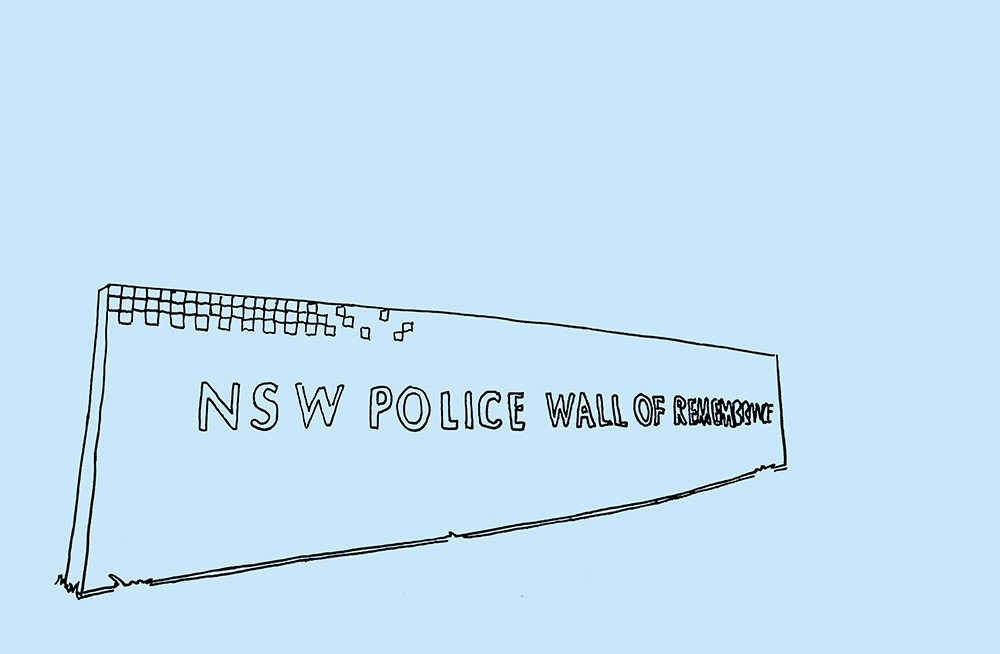
By John Citizen
6 December, 2019
ARRIVALS & ART GALLERY OF NEW SOUTH WALES
On the way to the Art Gallery of New South Wales (AGNSW) I pass three things: the New South Wales Police Force Wall of Remembrance; a Navy officer (walking to work); and, a bronze statue inscribed with the text ‘the offerings of war.’
BUILDINGS & BREAK-ROOMS
Before my first shift at work, I sign an induction document that amounts to a pledge of commitment to safety and security. The main takeaway is: the institution ‘must be kept secure at all times.’
I am taken on a tour of the building and the break rooms. The first break room is in the guts of the building, in the basement. It’s a largely uninviting sterile line-up of white tables and chairs, kind of like a classroom crossed with a hospital waiting room. The second break-room—on the top floor—couldn’t be more different. Rather than walking through the loading dock, to get to this break room you walk past the offices of executives who bob around in nice suits. It has floor-to-ceiling windows with harbour views, a fully stocked espresso machine, plush lounges, a folder with a stack of shared crosswords.
Spatially speaking, the executive occupies the highest point of the building. This spatial disjuncture mirrors a taken-for-granted logic that structures all workplaces under capitalism: bosses dictate the conditions, and their conditions will always be, if not luxurious, at least more-endurable. Sly anti-workerism figured through executive privileges: this is so contemporary.
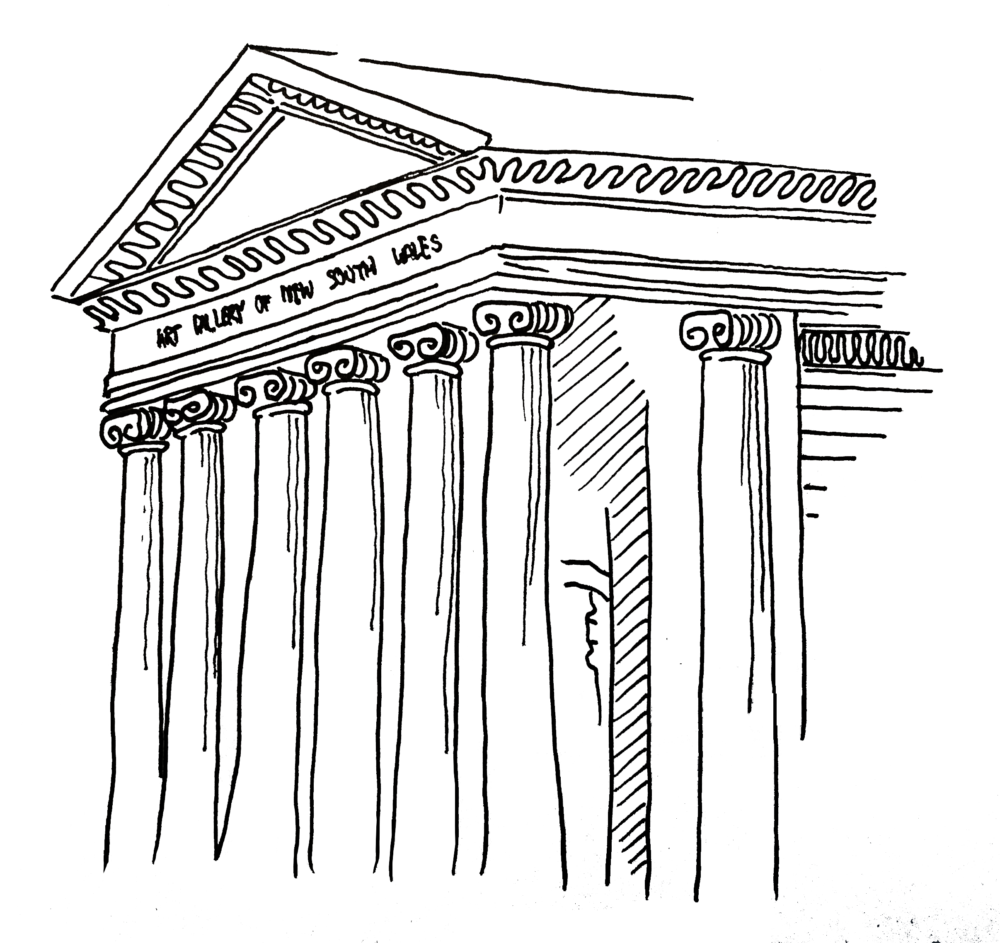
CONTEMPORARY
I arrive at AGNSW. Jump down to Level 2, to the Making Art Public: 50 years of Kaldor Public Art Projects exhibition, where Tino Sehgal’s performance work This Is So Contemporary (2005) is being restaged. Three nondescript performers dressed in gallery attendant uniforms—security guard suits-and-ties—stand with their backs against the walls of the gallery. When audience members enter, or pass into the space, the security guards spring out of position. They encircle the audience member, dance around them with jazz hands, singing, chanting and whispering, ‘this is so contemporary, contemporary, contemporary. This is so contemporary, contemporary, contemporary.’
Some people are surprised. Others are in on the joke and sing along. Some people collapse into fits of laughter and dance in and out of the space to re-trigger the performance. A few kids seem genuinely scared, urging ‘let’s get out of here bro’ as they scurry out of the circle. Mostly, people are caught off guard.
Sehgal’s shtick is mutability, meaning his instructions for the staging of each artwork shifts according to context (for example, if this performance were at the Museum of Contemporary Art it would take a radically different shape, given the gallery attendant uniform there is a casual black T-shirt).
At AGNSW, however, the adoption of the security guard uniform in this iteration of Sehgal’s work offers an opportunity to reflect on a number of collisions that are so contemporary. The collision of security guards with private property, of police with the powers of interpretation, of the art philanthropist with the public, of uniforms with bodies, of space with invisible lines, of cops with plain clothes. I’m not suggesting that the performers are quite-literally cops—I know they’re mostly dancers or artists or performers dressed in suits and blue ties. But rather, we might read This Is So Contemporary as unwittingly indexing a broader—largely invisible—culture of securitisation and policing that we all live under, amongst and against every day.
DOCUMENTATION
Tino Sehgal’s artworks are famously not to be documented. Not photographed, not filmed, only ‘experienced.’ As the Kaldor Public Art Project’s website reads, ‘his works remain somewhat of a mystery to those who have not directly experienced them.’ A person dressed in plain-clothes flanks the edges of the gallery to actively enforce this no-videos rule.
Let’s be clear: respecting an artist’s wishes not to photograph a performance is not the same thing at state-sanctioned censorship. But, this aspect of the work does draw our attention to broader—and very much alive—questions of documentation and censorship in Australia. There is something so familiar in the gesture of a policeman reaching outwards to cover a camera lens in a large crowd. A friend told me this week that the NSW police cleared his camera’s memory card at a recent protest. Conversely, how many stories have we heard about police body-cam footage of state-sanctioned brutality supposedly ‘going missing’? It’s hard to cite a gesture, a feeling circulated between crowds, a conspiracy theory, a piece of gossip, but that doesn’t mean it’s not there. While we are increasingly made-to-be unwilling objects of surveillance, the cops continue to dictate what is, and is not, afforded documentation: this is so contemporary.
ECOSYSTEM & ECONOMY
Browsing the Art Gallery of New South Wales’ sponsor list, one of their top corporate partners is EY Global. On EY Global’s website, a banner image reads ‘DRONES – BUILDING A NEW BUSINESS ECOSYSTEM IN THE SKY’—heralding the financialisation of the sky through military technologies. I’m reminded of 2014, when artists boycotted the Sydney Biennale because of Transfield’s major corporate sponsorship. At the time, Transfield received around $1.4 million dollars every day to manage Australia’s offshore prisons on Manus and Nauru. Arts, money and militarism: this is so contemporary.
FINANCE
Of the Transfield controversy, Johanna Mendelson wrote that it is ‘infantile to pick on one holding company of one of the camp operators while ignoring the central role of the Australian government which is directing the whole disaster [of indefinite detention].’ The point being, the arts rely on federal and state government funding as much as they do on corporate entities. The inextricability of a settler-government from capital, and no capital being clean capital: this is so contemporary.
GOVERNMENT & GIFTS
In 2011, it was announced that John Kaldor— the textile businessman, arts philanthropist, collector and millionaire—was donating his $35 million collection of contemporary art to the Art Gallery of New South Wales. The gift was touted as the largest act of private benefaction to any public Australian art gallery, with an article published at the time deeming it the result of ‘a complex dance of money, taste and politics that will see the last big space in the Art Gallery of NSW dedicated permanently to international contemporary art.’ One of the requirements of the bequest was that the AGNSW construct a gallery space dedicated to ‘always’ displaying Kaldor’s collection. An observation: the Art Gallery of New South Wales is a public, government institution—a spatially significant proportion of which is dedicated in-perpetuity to the private bequest of one man. As Rebecca Coates writes, the gifts of corporate sponsors and collectors inevitably shape the priorities of arts institutions, as well as significantly impacting the direction of institutional resources. In the media, Kaldor’s gift has almost been exclusively praised. Still, I can’t shake the feeling that The Private Collector should be anathema to the Public Gallery. The agenda-setting power of capital: this is so contemporary.
HUMAN RESOURCES
A Tweet I once saw, by the poet-writer Dan Hogan: ‘HR is made for giving gold stars to scabs.’
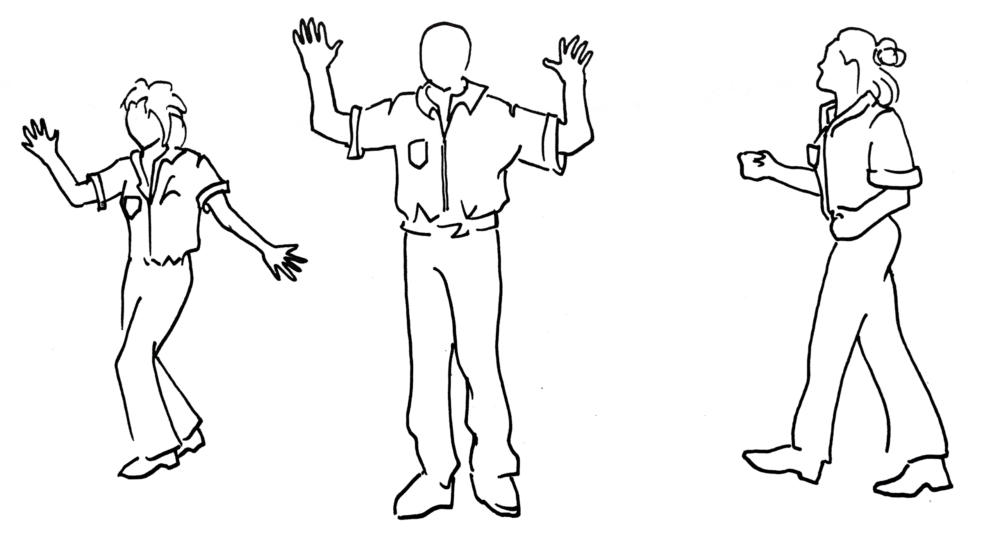
INTERPRETERS
Using the artist’s terminology, the performers in Sehgal’s performance aren’t actually called performers. They are interpreters. Watching the This Is So Contemporary interpreters for a long while, it’s hard to tell what the trigger for the performance is. How do they decide who to spring on? Is it a spatial cue, like someone walking across an invisible line? Is it random? But, if it is random, why then do they never seem to spring on groups of school kids? Put differently, the artwork seems discretionary, but the terms of that discretion are unclear. I’m thinking about how this logic pervades in contemporary policing—so much of which is the radically unpredictable and discretionary work of interpretation. The discriminatory and patchy application of the law: this is so contemporary.
JOB SECURITY
For all this high-security culture, could we at least get some job security around here? The right of a boss to terminate a contract at any time, without notice: this is so contemporary.
KALDOR
Ben Davis writes in 9.5 Theses on Art and Class, ‘concretely, within the sphere of the contemporary visual arts, the agents whose interests determine the dominant values of art are: large corporations, including auction houses and corporate collectors; art investors, private collectors and patrons; trustees and administrators of large cultural institutions and universities.’ Public art as always-already private: this is so contemporary.
LEAKS
I watch a pigeon casually wander into the gallery’s glass doors, in through the café, past tables of boomers eating $16.50 meat pies, past the escalators, and into a gallery. I fantasise about the bird taking a shit on one of the colonial fictions on the wall or leaving an imperceptible trail of pigeon dust on the marble floors. Secure buildings that leak: this is so contemporary.
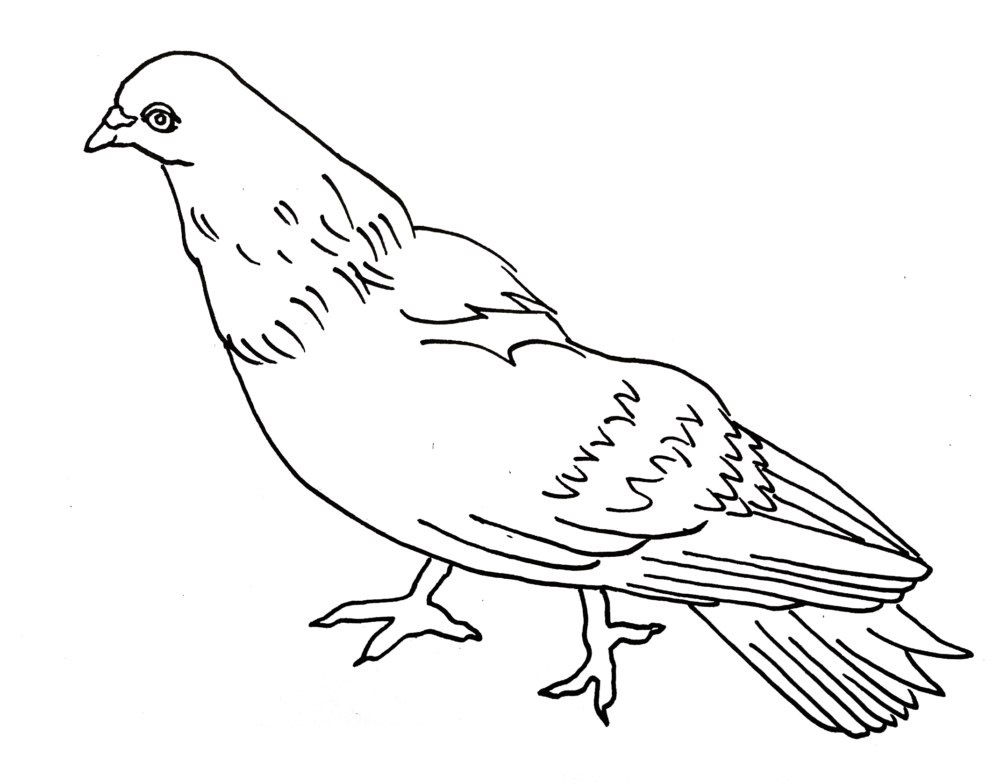
MANAGEMENT
Gossiping about a different Australian arts institution, a friend tells me that when applying for an invigilator role there were around fifty people in the group interview. The Human Resources staff embedded themselves, in plain clothes, in the crowd of prospective employees. They would surveil, converse and overhear the interactions between all of the people who wanted jobs at the gallery. As a worker’s first encounter with their future workplace, this scenario seems to me a textbook induction into the almost-inevitable reality of hating a job, of being surveiled by a boss, of evading embedded snitches and the cruelty of management. Kassandra Vee: ‘like hating the police, hating your job is one of the most beautiful and natural things you can do.’ Hannah Black: ‘the police are everywhere.’
NOVELTY
In essence, This Is So Contemporary makes a novelty out of the act of being swamped, surrounded and sung-at by security guards. Kaldor Public Art Projects describes the work as ‘spontaneous and contagiously uplifting.’ While this seems to be true for a majority of visitors I witness who interact with the performance, I think it’s worth probing: spontaneous and contagiously uplifting for who? Even with the knowledge that these people are performers, that this is a contrived situation, something about the work puts me on edge, raises my heartbeat, and feels a little mortifying. I watch as some people keep their head down and walk right through the circle, trying to ignore the repetitive chants of the guards. It might be worth remembering: many people in Australia live under the constant threat and reality of being spontaneously circled by security guards (in their many forms) everyday; for many, there might be nothing novel or uplifting about Sehgal’s work.
OBEDIENCE
Relatively speaking, at one of my jobs my labour is fairly unmonitored; that is, my time and body are largely (unusually) unaccounted for. I rock up, do the thing, leave, submit timesheets. Why, then, do I still arrive ten minutes early for work? Take my breaks at prescribed times? Why not skip a shift altogether? Fake a time card? Steal more time? Ritual obedience for fear of retribution: this is so contemporary.
POLICE & PLAIN CLOTHES
I once lived in a small town of mostly middle-class white people, where a single cop was stationed. His name was Simon. Simon and I started our jobs at the same time. The Facebook comments on the post announcing his appointment read ‘mate I don’t think the NSW Police could have found a better man’ and ‘living your dream.’ Being the only cop, he was yet to establish his reputation, so I was able to witness the initial stages of his identity formation. Simon did all he could to collapse the boundary between himself (The Cop) and the community (The Policed). He never wore his indigo cop uniform, and insisted on being called ‘Simo’, rather than Constable or Sheriff. The persona that he intentionally cultivated for himself: the at-arms-length Local Chill Dad at a local barbeque.
For all intents and purposes Simon tried to be undercover—apart from the fact that we all knew he was a cop, he acted like a cop, he smelt like a cop. Throughout these early months of intentional identity formation, he cultivated a reputation as the Cool Cop. He made a conscious effort to remind us when we were committing minor infringements, and that he was choosing not to apprehend us. He would call out from his cop car: ‘hey [redacted name], $319 for no bike helmet.’ Then he would wink and drive off. This way, no one would bat an eyelid when Simon would drop into work, cargo shorts at the knees, and casually enquire about how meth was getting into town. Plain clothes and priming snitches: this is so contemporary.
QUESTIONS
Question: what is a cop? Answer: ‘he is the active servant of the commodity.’ Question: and in Australia? Answer: ‘in the settler colony, the police serve to preserve and protect private property which, along with the right to possess, is foundational to the state’s sovereign claim.’ Question: what is the State of the cop? Answer: ‘people are so intimidated in the state of New South Wales. Fear has become habitual. The pressure that the police apply then goes down through to the licencing police, through to private security, who are looking after anything from university libraries through supermarkets to nightclubs. And we have all become so accustomed to that kind of pressure.’ Generalised atmospheres of anxiety: this is so contemporary.
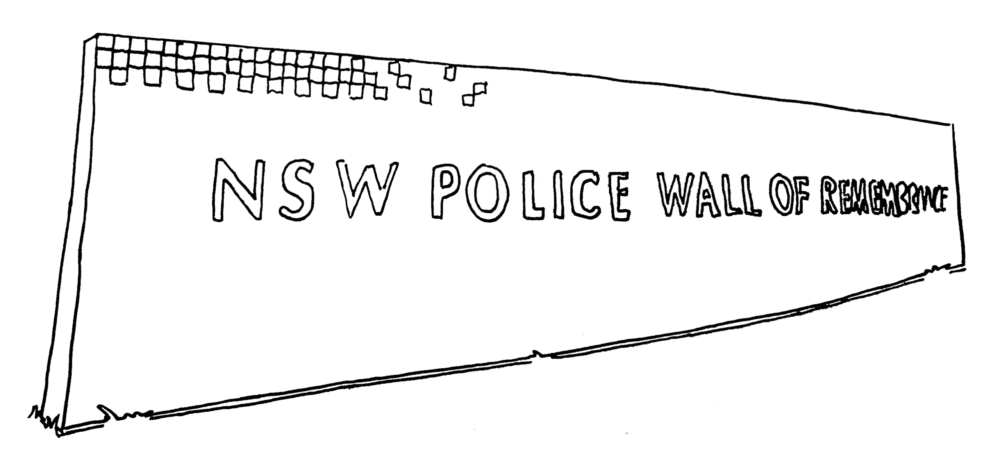
REMEMBERANCE
Adjacent to the art gallery is the NSW Police Wall of Remembrance: a marble-engraved memorial for dead cops. These memorials are just one way the police depict themselves as the de-historicised and individualised victims of violence, rather than the direct bearers of structural violence.
SECURITISATION
To cite Javier Arbona, the ‘spatial and rhetorical manoeuvres’ enacted in police memorials ‘reveal a different dimension of what “security” means: the protection of police within a generalized environment of increasing insecurity for anyone resisting oppression.’ Securitisation: this is so contemporary.
TRUST
The sign-in and sign-out of radios and security passes at work is carefully monitored. Once, when returning my radio, someone makes a joke: ‘what? Don’t they trust you?..ahah…haha…ah.’ The punch line: a government institution trusting a worker. Signatures and time cards: this is so contemporary.
UNIFORM
At work, the radio on my belt signals I am entitled to a staff discount at the building’s café. At a restaurant I used to work at, the point of sale machine came with an automatic option: a 25% discount for cops. A friend tells me that in Darwin military officers have a casual uniform option. The army realised that soldiers wanted to signal their service in places where they weren’t formally allowed to wear their uniforms, so they designed a kind of pseudo-resort-wear option. Like, a casual t-shirt and shorts that you can wear to pick up the kids from school, but make it military. And, the performers in This Is So Contemporary wear security guard uniforms. Cops trying not to dress as cops, non-cops dressing as cops: this is so contemporary.
VIOLENCE
Mariame Kaba: ‘History offers evidence of the intractability of the problem of police violence. What should we do then? Quite simply, we must end the police. The hegemony of police is so complete that we often can’t begin to imagine a world without the institution. We are too reliant on the police.’
WEATHER & THE WHOLE WORLD
‘When we say, with poet Miguel James, that all our prose is against the police, we don’t simply mean the ugly racist in a blue uniform over there, we mean the whole world that he stands for and protects.’
Leaving AGNSW, I pass that cruddy police memorial and the ‘this is so contemporary, contemporary, contemporary’ refrain is stuck in my head. It looks in pristine condition, but I’m thinking about my favourite news article written about that memorial, which pulses with the conspiratorial anxiety of settler-policing. The by-line reads, ‘fears Sydney’s police wall of remembrance had been desecrated again have proven unfounded, with weather blamed for stripping polish that had been used to cover earlier vandalism.’ Storms, wind and rain eroded the marble’s polish so much that it revealed the existence of scratches and damage left by someone in a past attack on the memorial. I like to think that the weather not only knows, but actively works to erode the veneer of contemporary policing. The return of past acts of resistance, and the weather’s haunting: this is so contemporary.